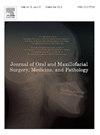用于牙科植入物的钆和硒掺杂生物活性玻璃表面涂层的开发、表征、生物相容性和腐蚀分析
IF 0.4
Q4 DENTISTRY, ORAL SURGERY & MEDICINE
Journal of Oral and Maxillofacial Surgery Medicine and Pathology
Pub Date : 2024-12-04
DOI:10.1016/j.ajoms.2024.12.002
引用次数: 0
摘要
目的制备新型钆和硒掺杂生物活性玻璃(gsBG)涂层钛牙种植体,并分析其表面、化学、腐蚀和生物相容性。方法采用溶胶-凝胶法,将45%正硅酸四乙酯(TEOS)在硝酸溶液中水解,然后加入硝酸钙、硝酸钠、正磷酸、钆和亚硒酸,制备gsBG。将混合物搅拌,浸涂在钛上,并在400℃下烧结。采用场发射扫描电镜(FE-SEM)、能量色散x射线(EDX)和傅里叶变换红外光谱(FTIR)对涂层进行了表征。用MG63细胞进行生物相容性测试,比较gsbg包被(A组)和裸钛植入物(B组)。在24、48、72、96和120 h时评估细胞活力。采用非配对学生t检验,统计分析两组在不同时间点对细胞活力的影响。用阻抗法和极化法分析了人工唾液的耐蚀性。结果SEM、EDX和FTIR分析证实gsBG表面在钛种植体上成功涂层。细胞培养后的共聚焦分析显示出良好的生物相容性。A组与B组间无统计学差异,P >;所有时间点均为0.05,表明所开发的种植体涂层作为裸钛表面具有生物相容性。腐蚀分析表明,所制备的表面涂层具有良好的耐蚀性和热稳定性。结论新型gsBG表面涂层作为种植体表面涂层具有良好的骨整合效果和长期种植成功的潜力。本文章由计算机程序翻译,如有差异,请以英文原文为准。
Development, characterisation, biocompatibility, and corrosion analysis of gadolinium and selenium doped bioactive glass surface coating for dental implants
Objective
This study aimed to develop novel gadolinium and selenium-doped bioactive glass (gsBG)-coated titanium dental implants and analyse their surface, chemical, corrosion, and biocompatibility properties.
Methods
A sol-gel method was used to prepare gsBG by hydrolysing 45 % tetraethyl orthosilicate (TEOS) in water with nitric acid, followed by adding calcium nitrate, sodium nitrate, orthophosphoric acid, gadolinium, and selenous acid. The mixture was stirred, dip-coated on titanium, and sintered at 400 °C. The coating was characterised using Field Emission Scanning Electron Microscope (FE-SEM), Energy Dispersive X-ray (EDX), and Fourier Transform Infrared Spectroscopy (FTIR). Biocompatibility was tested with MG63 cells, comparing gsBG-coated (Group A) and bare titanium implants (Group B). Cell viability was assessed at 24, 48, 72, 96, and 120 h. An unpaired student t-test was performed to statistically analyse the effect of both groups on cell viability at various time points. Corrosion resistance was analysed via impedance and polarisation in artificial saliva.
Results
The SEM, EDX, and FTIR analysis proved the successful coating of the gsBG surface on the titanium implant. Confocal analysis following cell culture showed excellent biocompatibility. No statistically significant difference was observed between Groups A and B, with a P > 0.05 noted at all time points, suggesting that the developed implant coating was biocompatible as a bare titanium surface. Corrosion analysis revealed that the developed surface coating was thermodynamically stable with high corrosion resistance.
Conclusion
The developed novel gsBG surface coating has shown great potential as an implant surface coating for better osseointegration outcomes and long-term implant success.
求助全文
通过发布文献求助,成功后即可免费获取论文全文。
去求助
来源期刊

Journal of Oral and Maxillofacial Surgery Medicine and Pathology
DENTISTRY, ORAL SURGERY & MEDICINE-
CiteScore
0.80
自引率
0.00%
发文量
129
审稿时长
83 days
 求助内容:
求助内容: 应助结果提醒方式:
应助结果提醒方式:


